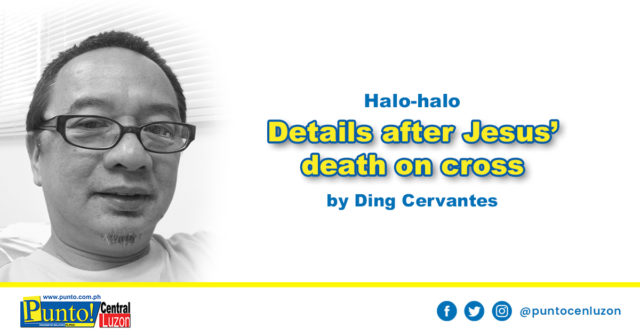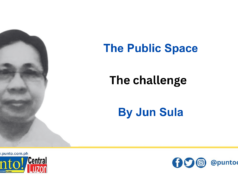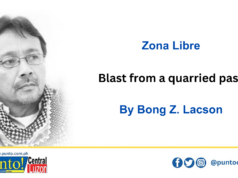FACEBOOK AND other such social media have descended so widely upon the world that I could only suspect the devil, sly as he is, would worm into it, as usual in a way that we would least notice, if at all.
I had suspected how, but Pope Francis could not have put it more precisely in his homily at the Vatican last Palm Sunday. He spoke about the battle between God and the “prince of this world,” saying those who follow Jesus are called to fight temptation and evil with silence and humility, not by being “superstars.”
The pontiff said that just as Jesus was welcomed joyfully into Jerusalem, the devil had a “card up his sleeve: the card of triumphalism.”
“Yet the Lord responded by holding fast to his own way, the way of humility,” Francis said, before telling thousands gathered in St. Peter’s Square that they, too, are called to do the same.
Triumphalism, Francis said, lives off gestures and words “that are not forged in the crucible of the cross,” growing off looks askance at others and by judging others as “inferior, wanting, failures.”
That is precisely what happens on Facebook and other social media. Most post anything that projects supposedly their best: their intellectual prowess, their possessions, their travels, their high acquaintances, why, even their virtues. This, without ever suspecting it’s all a case of the modern gospel being spread in Hollywood and, in typical Filipino copycat fashion, in the local entertainment business: Learn to love yourself. As if we have always been too selfless.
Faced with Holy Week, I am again sharing the writings of mystic Maria Valtorta (1897-1961) who was privileged to be taken back in time to witness the life of Jesus Christ and more, including episodes in the Old Testament and even the Final Resurrection.
Many have been written about the details of Jesus’ torture leading up to his death on the cross. So, it would be of interest to share here the events after His death on the cross as witnessed by Valtorta. What follows are direct quote from her, although I have removed some paragraphs for purposes of brevity.
Valtorta wrote (I minimized direct quotation marks):
His head falls on His chest, His body leans forward, the trembling stops, He breathes no more. He has breathed His last.
The Earth replies to the cry of the murdered Innocent with a frightening rumble. From a thousand bugle-horn giants seem to give out only one sound and on that terrible chord there are the isolated rending notes of lightning that streaks the sky in all directions, falling on the town, on the Temple, on the crowd… I think that some people were struck by lightning, because the crowd was struck directly. The lightning is the only irregular light that enables one to see at intervals.
And immediately afterwards, while the volley of thunderbolts still continues, the earth is shaken by a cyclonic whirlwind. The earthquake and the tornado join together to give an apocalyptic punishment to the blasphemers.
The summit of Golgotha trembles and quakes like a plate in the hands of a madman, because of the subsultory and undulatory shocks that shake the three crosses so violently that they seem on the point of being overturned.
Longinus, John, the soldiers grab whatever they can, as best they can, not to fall. But John, while grasping the cross with one arm, with the other supports Mary Who, both because or Her grief and the unsteadiness, has leaned on his chest. The other soldiers, and in particular those on the side sloping downhill, have had to take shelter in the centre, to avoid being thrown down the precipice.
The robbers howl with terror, the crowd howls even more and would like to run away. But it is not possible. People fall one on top of the other, they tread on one another, they fall into the fissures of the ground, they hurt themselves, they roll down the slope as if they had gone mad.
The earthquake and the tornado recur three times, then there is the absolute immobility of a dead world.
Only flashes of lightning, without the rumble of thunder, still streak the sky illuminating the scene of the Jews fleeing in every direction, at their wits’ end, their hands stretched forward or raised to the sky, at which they had so far sneered and of which they are now afraid. Darkness is mitigated by a dim light which, increased by the silent magnetic lightning, enables one to see that many are lying on the ground, I do not know whether they are dead or have fainted. A house is on fire inside the walls and the flames rise up straight in the still air, a bright red spot in the grey-green atmosphere.
Mary raises Her head from John’s chest and looks at Her Jesus. She calls Him, as She cannot see Him well in the dim light and Her poor eyes are full of tears. She calls Him three times: « Jesus! Jesus! Jesus! » It is the first time that She calls Him by His name, since She has been on Calvary. Then, as a flash forms a kind of crown over the top of Golgotha, She sees Him, motionless, all bent forward, with His head hanging so much forward and to the right, that His cheek touches His shoulder and His chin rests on His ribs, and She understands. She stretches out Her hands in the dark air and shouts: ‘My Son! My Son! My Son!’
John, who has also looked and heard and has understood that everything is over, embraces Mary and tries to take Her away saying: ‘He no longer suffers.’
But before the apostle finishes his sentence, Mary, who has understood, frees Herself, She turns round, She bends towards the ground, She covers Her eyes with Her hands and shouts: ‘I no longer have My Son!’
She then staggers and would fall if John did not hold Her against his heart, and he then sits down, on the ground, to sustain Her on his chest, more easily until the Maries, no longer held back by the upper circle of armed soldiers – because, since the Jews have run away, the Roman soldiers have gathered in the open space below, commenting on the event – replace the apostle near the Mother.
The Magdalene sits where John was, and she almost lays Mary on her knees, holding Her between her arms and her breast, kissing Her deadly pale face, which is reclined on her compassionate shoulder.
Joseph and Nicodemus appear from behind the rock. They had certainly taken shelter there, behind the protection of the mountain, to save themselves from the thunderbolts. They go to Longinus. ‘We want the Corpse.’
‘Only the Proconsul can grant it. Go quick, because I heard that the Judaeans want to go to the Praetorium to obtain permission to fracture His legs. I would not like them to disfigure His body.’
‘How do you know?’
‘A report of the ensign. Go. I will wait.’ The two men rush down the steep road and disappear
It is at this moment that Longinus approaches John and in a low voice says something to him, which I do not understand. Then he makes a soldier give him a lance. He looks at the women, who are all attending to Mary, Who is slowly recovering Her strength. They have all their backs turned to the cross.
Longinus places himself in front of the Crucifi ed, he ponders carefully how to deal the blow and he strikes it. The lance penetrates deeply from the bottom upwards, from right to left.
John, wavering between the desire to see and the horror of seeing, makes a wry face for a moment.
‘It is done, my friend’ says Longinus, and he ends: ‘Better so. As for a knight. And without fracturing bones… He was really a Just Man!’
To be continued





